The types of Bourbon coffee, the main variety of Arabica
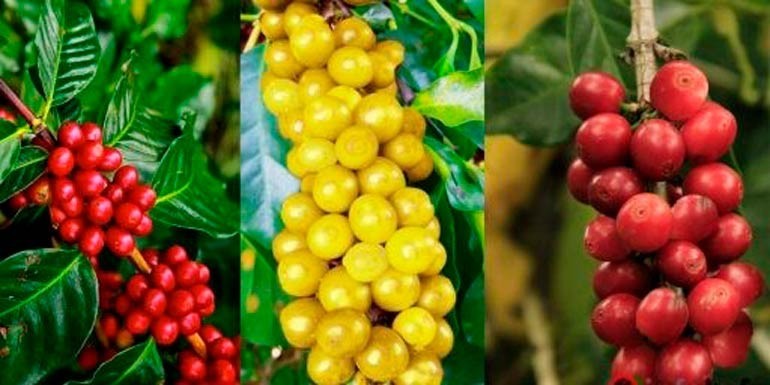
Get to know the coffea or coffee tree, the plant that produces coffee beans
Coffee beans, as we know them, are the two half-seeds that are found inside cherries that are created after the flowering of a plant, the coffee plantation, which belongs to the botanical family of Rubiaceae, more specifically to the genus Coffea.

In general, it is a plant with perennial, oval and elongated leaves, which are born on the branch in an opposite way, two by two. Its flowers are white, with 5 petals and a scent that is slightly reminiscent of jasmine. Some wild specimens can reach up to 15 meters in height.
With this post you will know the COFFEE ORIGINS: BOURBON KIBIRA. Enter our online store and taste this silky-bodied coffee that has citrus fruit notes and fine chocolate notes.
These are the coffee species:
Broadly speaking, two species of the coffee plant are distinguished: Arabica, which represents around 70% of world production, and Robusta (also called Canéfora), which represents 28%. There are other species, such as libérica or Abeokutae, although they are residual in volume.
The Arabica species is more appreciated, since the infusion of its grains has a more attractive flavor and aroma for consumers. On the other hand, robusta coffees tend to be more bitter and full-bodied.

How are ARABICA COFFEE:
There are a large number of varietals (or varieties) of Arabica coffees, either due to natural mutations (by wild spread from birds and small animals) or the result of human hybridization.
Except for those wild bushes that grow spontaneously, producers generally choose to cultivate a certain variety for different reasons, such as yield (the number of grains per plant), the environmental conditions of the area, the soil or the resistance of the plants to diseases. .
The different varieties of coffee do not only differ in taste and organoleptic profile, but they are also visually different plants. If you look at the shape and height of the tree, as well as the characteristics of the cherries and the leaves, some varieties can be more easily recognized.

Next, we are going to review some of the most representative, as a small introduction:
1. Get to know the coffee of the Típica group of the Arabica variety
Origin: La Típica is the original coffee plant, discovered in the Kaffa jungle (Ethiopia), thousands of years ago, and later in Yemen. About the year 1700, the French troops managed to take some seeds to Central America. It is the base from which many other varietals have subsequently emerged (such as Mundo novo, Maragogype,...). Currently, apart from Ethiopia, it is taken into account in the producing areas of Central America, Jamaica and Asia.
Characteristics of the plant: it has a low yield (each bush produces few cherries). The plants are conical in shape with a vertical main trunk and can reach 5 meters in height. The distances between the branches are greater than in other varieties. The lateral branches form angles between 50 and 80º with the vertical stem. Both the trunk and the branches are not very thick.
The leaves, cherries and green beans are generally elongated, and most distinctively, the tips of the leaves are bronzed when young. Furthermore, the leaves have a smoother surface and less wavy edges than other Arabica varieties.
Cherry and Cup Characteristics: Tipica cherries turn bright red when ripe. Oval in shape and very high quality. It has a clean, sweet flavor, good body and slightly acid in the cup.

2. Get to know the coffee of the Bourbon group of the Arabica variety
Origin: It is a natural mutation of the typical variety. It was transplanted to Yemen, and from there, the French introduced it to the current Reunion Island (near Madagascar), at that time it was a colony known as "Bourbon", in honor of the Bourbon dynasty that reigned at that time. It is currently found in Rwanda, Burundi and in some Central American countries.
Plant Characteristics: Bourbon has the same tall stature and conical shape as Typica, but is slightly bushier, with more secondary (lower) branches. The trunks and branches are somewhat thicker, making it a less flexible plant than that of Typica. In addition, the distance between the branches is smaller, being denser and more productive than the typical one (although it is still a medium-low yield).
The leaves are broader than those of Typica and have an irregular texture with wavy edges. It is a delicate shrub, with little resistance to rust and other diseases and pests. It can survive at high altitudes.
Characteristics of the cherries and cup: The cherries are round and rather small. When ripe, they stain a range of shades of red, pink or yellow (but they do not vary on the same plant, the color depends on the varietal). Its cup is of very high quality, medium yield and great characteristic sweetness (reminiscent of caramel), its infusion is balanced and with a complex acidity.
Later in this article we will delve a little more into this variety than we have COFFEE ORIGINS: BOURBON KIBIRA. Enter our online store and taste this silky-bodied coffee that has citrus fruit notes and fine chocolate notes.
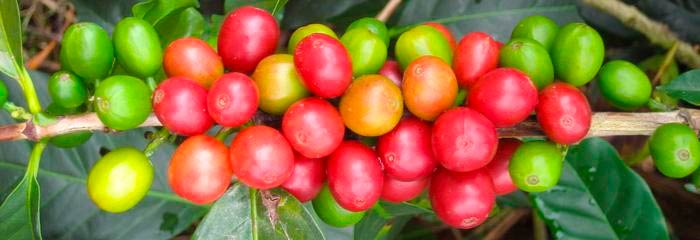
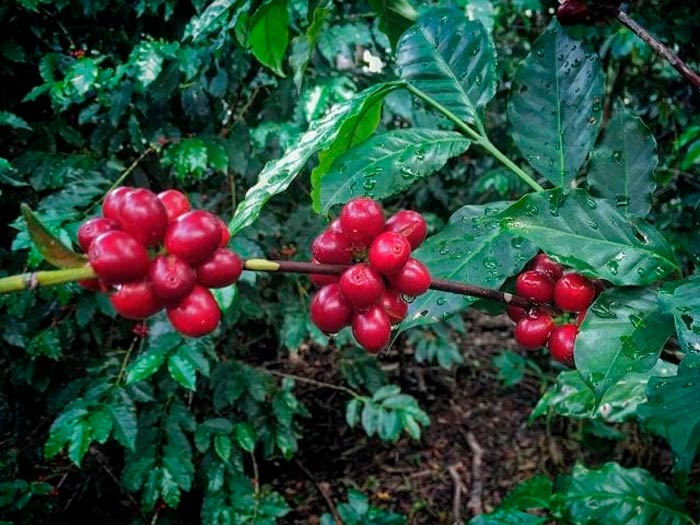
3. Meet the coffee of the Caturra group of the variety
Origin: La Caturra is a dwarf mutation of Bourbon, which occurred naturally. Very common in countries with a great coffee tradition in Central America: Colombia, Nicaragua, Costa Rica.
Characteristics of the plant: It is much shorter and denser than its plant relative (a dwarf bourbon, so we understand each other). The distance between the branches on the trunk is shorter and it has many secondary branches. Thanks to this, Caturra is a more leafy plant than Típica or Bourbon.
As for the rest, it has very similar characteristics to Bourbon: its large leaves have wavy edges and green tips. It is a medium-yielding plant (although higher than Bourbon) and somewhat delicate, as it is not very resistant to rust and other diseases.
Its short size and higher yield make it a very widespread and appreciated varietal among producers.
Characteristics of the cherries and cup: The cherries are also round, of average size and turn red or yellow when ripe. In the cup it distills a citric acidity, and despite being of high quality, it has less body and sweetness than the Bourbon variety.


4. Meet the coffee of the Catuaí group of the variety
Origin: Catuaí is a cross between Mundo Novo and Caturra. Just as Caturra is a natural mutation of Bourbon, Mundo Novo is a natural mutation of Típica. It maintains a good part of the characteristics of the Caturra.
Plant characteristics: The plant is relatively short and the lateral branches form narrow angles with the primary branches. It is unusual to see secondary branches at the top of the plant and this gives it a more umbrella-like shape than is the case with Typica and Bourbon, both of which have a conical shape.
Catuaí leaves are wavy and generally have green tips. The fruit does not fall from the branch as easily and this makes it a good option for areas with rain or strong winds. It is a high yielding variety.
Characteristics of cherries and cup: Produces round, medium sized cherries. In general, they turn red or yellow when ripe, but there are rare cases of orange Catuaí. The cherries are of quality and medium size.

5. Get to know the coffee of the Geisha / Gesha group of the Arabica variety
Origin: It is a plant native to the Gesha region, in Ethiopia, and was successfully planted only in Panama. Since then the Geisha of Panama has become one of the most famous cafes in the world, for its excellence and exclusivity.
Plant Characteristics: It is easy to recognize this extremely popular variety thanks to the angle of the upper branches and the shape of the plant. The branches at the top stretch "towards the sky" at an angle of between 45 and 50º. Geisha/Gesha has a tall stature, can reach 5 meters, with a large distance between branches and nodes. The trunk and branches are thin.
It is a very delicate variety and very susceptible to weather and soil conditions, hence its exclusivity. It grows at high altitudes, above 1400m. It is a very stylized plant, with the leaves are smooth and elongated
Characteristics of the cherries and cup: the cherries are also elongated in a similar way to the fruit of Típica. Geisha/Gesha cherries taste very different from other varieties: they have citrus notes, fruity sweetness and a floral element reminiscent of jasmine.
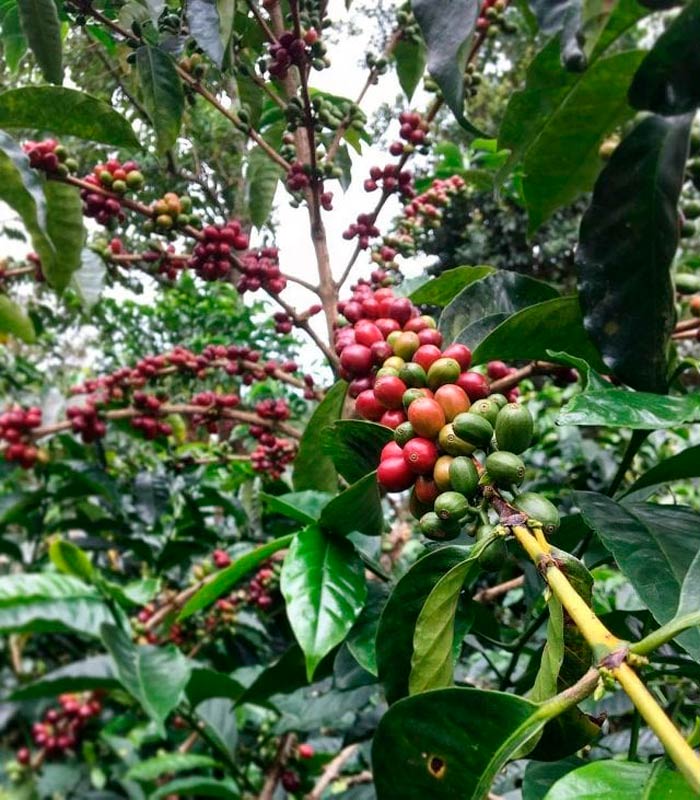
The Bourbon variety: Everything you always wanted to know and never dared to ask...
The origin of the Bourbon variety
The origin of this varietal is located in Yemen, possibly around the 14th-15th century. In the 17th century, the Sultan of Yemen presented the King of France, Louis IV, with some coffee trees, which were successfully planted on what is now Reunion Island (next to Madagascar), due to its fertile volcanic soil and its tropical climate.
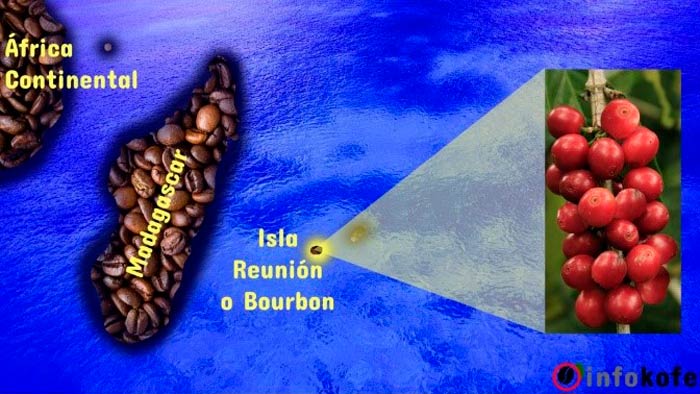
This island was a French colony since it was occupied in 1638 and renamed "Isle Bourbon" by decree of Louis XIII, who was from the "Bourbon" dynasty. Hence its name. In 1793 the Bourbon dynasty was overthrown and the name was changed to Reunion Island.
Later, the French missionaries began to introduce Bourbon in the most related territories (Africa, the current Rwanda and Burundi) and in Central America, where it is still produced today…. And curiously, it is no longer produced on Reunion Island.
Because it is one of the first known varietals, it became a fairly widespread coffee variety, which later spawned other varietals, "la caturra" being the most famous.
There are other types of Bourbon coffee that are called different depending on their origin.
Kenya/Tanzania: Arusha
Guatemala: El Chocó.
Costa Rica: Tico which is a hybrid.
Honduras: The lover.
El Salvador: Salvadoran or TX.
How many types of varietal are there? Bourbon in colors
There are three varieties of Bourbon based on its color: red, pink and yellow.

Red Bourbon Coffee
It is the most common. The fruit in this case is a dark reddish color.
Its aroma is slightly floral and has notes reminiscent of caramel, citrus grapefruit, vanilla... Its flavor has a touch of vanilla, initial fruit, some chocolate, spicy. Medium-high citric acidity, medium dense body.
Our COFFEE ORIGINS: BOURBON KIBIRA is a Red Bourbon coffee. Enter our online store and taste this silky-bodied coffee that has citrus fruit notes and fine chocolate notes.
Yellow Bourbon Coffee
Some time ago, it became one of the most widely produced varietals worldwide, but due to its low productivity it has been replaced by higher-yielding crops. Some farms continue to allocate a little of their cultivation to Yellow Bourbon so that it does not disappear.
Its fruit has a large amount of fructose, resulting in a grain with floral notes similar to jasmine, body and low acidity.
rosé bourbon coffee
Pink Bourbon coffee is a genetic mix between Red and Yellow Bourbon. This varietal is highly sought after due to its genetic rarity and the difficulty of being cultivated and harvested.
Its fruit has a large amount of glucose, which produces a silkier body and cup.
Other considerations of the Bourbon varietal
Where is it best grown? The high altitudes (It is grown between 1,000 and 1,800 meters above sea level) and nitrogen-rich volcanic soils highlight the sweet characteristics and the great body of Bourbon. Its ideal cultivation is "under shade", since it allows the cherries to ripen properly and can be harvested at its optimum state of maturity. In general, this results in lower performance, but higher quality.
How should the fermentation be? Regarding the fermentation methods, the honey and natural processes are the most indicated to highlight its sweetness. For this, the absence of rain must be guaranteed, as well as special care so that its sugars are not lost.
How should the roast be? The Bourbon variety has a density and high glucose content and a complex chemical composition, which requires attention during roasting. Roasting small batches at higher load temperatures for a shorter period of time is ideal for developing denser beans.
Its cup is characterized by a floral aroma, citrus and caramel notes with a medium-low acidity.
Threats and future of the Bourbon varietal
What diseases can affect you? Bourbon is a delicate variety, very susceptible to diseases such as borer, rust or other pests; therefore, it requires great dedication to keep it healthy. The rust crisis affected Bourbon producers in Colombia in 2012, causing many to start growing other, more resistant varieties.
What kind of care do you need? Climate change, which translates into rising temperatures and a shift towards more irregular rainfall patterns, is also taking a heavy toll on this variety, leading to unpredictable harvests and premature ripening of cherries. This adds extra difficulty to the producer's work in order to maintain the final quality of the cup.
Bourbons have the potential to produce incredible cups of coffee. However, it is clear that for growers to grow it successfully, additional time and care must be devoted to it.
How do the new varieties "affect" you? Bourbon has played a key role in the history of coffee, however, it faces important difficulties for the future. As new varieties are developed that offer coffee growers fewer dilemmas between tasting quality and agronomic characteristics of interest (yield, disease resistance, drought tolerance, etc.), this varietal will be less and less frequent.
Regardless, there will always be bourbon lovers. Coffee growers who appreciate its characteristics and who are willing to pay the extra price that its special care requires. In this aspect, Bourbon is going to be more scarce and exclusive, playing a great role in specialty coffees.
If you have been wanting to have a bourbon coffee, we recommend COFFEE ORIGINS: BOURBON KIBIRA Enter our online store and taste this silky-bodied coffee that has citrus fruit notes and fine chocolate notes.
Recent posts
-
Pacamara Nicaragua: Exploring the Coffee Treasures of Nicaragua 23/04/2024Cup of Excellence from a unique place in the world: the Apaneca-Ilamatepec volcanic mountain range 27/11/2023Safari through Ethiopia, a jewel called "Heirloom" 22/06/2023Discover the sensory experience of Brazilian Caracolillo Coffee 11/05/2023
Comments
Log in or register to post comments





